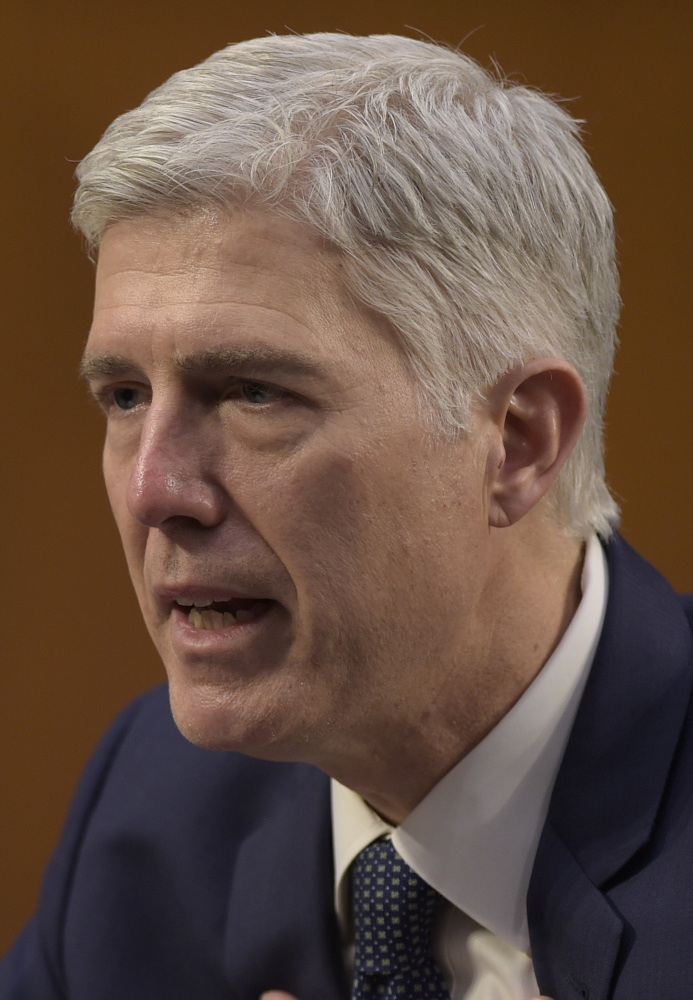WASHINGTON — Republicans have put President Trump’s Supreme Court nominee on the bench, and they’re now in a position to fill dozens more federal judgeships – and reshape some of the nation’s highest courts.
Democrats have few ways to stop them.
The Republicans’ opportunity comes with their party in control of Congress and the White House, about 120 vacancies in federal district and appeals courts to be filled and after years of partisan fights over judicial nominations.
Frustrated by Republican obstruction in 2013, then-majority Democrats changed Senate rules so judicial nominations for those trial and appeals courts are filibuster-proof, meaning it takes only 51 votes, a simple majority in the 100-member Senate, for confirmation.
Today, Senate Republicans hold 52 seats.
The Democratic rules change did not apply to Supreme Court nominations. But Senate Republicans are now in the majority, and they changed the rules in similar fashion this month to confirm federal Judge Neil Gorsuch to the high court over Democratic opposition. As a result, the party can almost guarantee confirmation of future Supreme Court justices, as well, if there are more openings with Trump in office and Republicans are in the majority.
“The Trump administration does have an opportunity to really put its mark on the future of the federal judiciary,” says Leonard Leo, the executive vice president of the conservative Federalist Society and an adviser to Trump on the Gorsuch nomination.
Reflecting a conservative judicial philosophy, Leo says the unusual number of vacancies that Trump is inheriting could reorient the courts of appeals, in particular, “in a way that better reflects the traditional judicial role, which is interpreting the law according to its text and placing a premium on the Constitution’s limits on government power.”
That philosophy was a priority for the late Justice Antonin Scalia, whom Gorsuch replaced, and Trump has said he wants the federal judiciary to reflect those values.
There are currently 20 vacancies in the federal appeals courts, which are one step below the Supreme Court, and roughly 100 more in district courts, where cases are originally tried. Former President Barack Obama had around half that number of vacancies when he took office in 2009. Of the current vacancies, 49 are considered judicial emergencies, a designation based on how many court filings are in the district and how long the seat has been open.
As the White House has focused on the Gorsuch nomination, Trump has so far only nominated one lower-court judge, Amul R. Thapar, a friend of Senate Majority Leader Mitch McConnell of Kentucky, for the 6th Circuit U.S. Court of Appeals.
Republican senators say they hope to see more nominations soon from the White House.
“We’ve heard from them and we’re talking to them,” says Texas Sen. John Cornyn, a member of the Senate Judiciary Committee and the No. 2 Republican leader.
The number of vacancies is a monumental opportunity for conservatives looking to exert more influence on a judiciary that they see as too liberal and activist. But it also could work to Republicans’ disadvantage. Democrats can’t stop the process, but they can delay it, and they still can call for procedural votes that will delay other Senate business when Republicans are trying to confirm each individual judge.
Democrats haven’t signaled a strategy for lower court judges, but partisan tension over the judiciary is at a peak after McConnell blocked Obama’s nominee for Scalia’s seat, federal Judge Merrick Garland, then changed the Senate rules to avert a Democratic filibuster of Gorsuch this month.
Send questions/comments to the editors.



Success. Please wait for the page to reload. If the page does not reload within 5 seconds, please refresh the page.
Enter your email and password to access comments.
Hi, to comment on stories you must . This profile is in addition to your subscription and website login.
Already have a commenting profile? .
Invalid username/password.
Please check your email to confirm and complete your registration.
Only subscribers are eligible to post comments. Please subscribe or login first for digital access. Here’s why.
Use the form below to reset your password. When you've submitted your account email, we will send an email with a reset code.